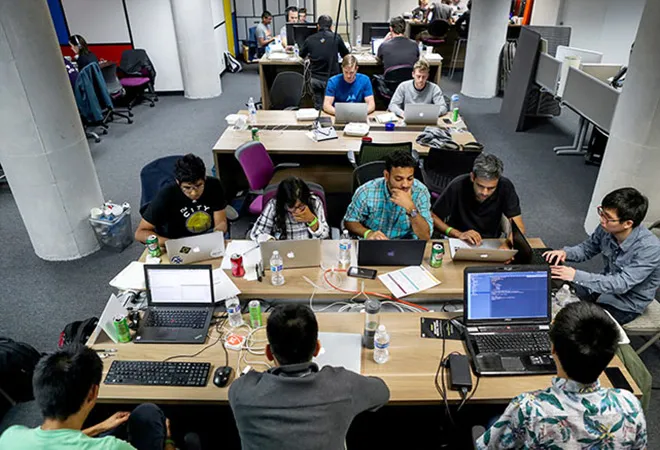-
CENTRES
Progammes & Centres
Location
Across the world, workforces 'stranded' by technological, regulatory, or climatic change have become politically crucial to the rise of populism

Finance has woken up to the problem of “stranded assets”. Typically, stranded assets are installations like thermal power plants that are being rendered unremunerative or unproductive ahead of time because of changes in the economic or political environment. For example, when it comes to coal-fired plants, climate change-related regulations might have been strengthened, input prices might have been increased or coal linkages removed, and alternative technologies such as solar power might have become more competitive than expected. It has now become clear that such problems need to be taken into account when examining the strength of balance sheets and the exposure of banks. Parenthetically, this is part of the reason why the government’s renewed emphasis on opening up coal mining to private players might be dangerous if funded by nationalised banks — it might lead to a further build-up of non-performing assets down the line.
Yet there is an analogue to the stranded assets problem that needs to be taken into account when planning development paths — and that is the problem of “stranded workers”. Across the world, such stranded workers have become politically among the most salient factors in the rise of populism. Consider the vast changes in the political landscape of the United States of America in the past three to four years. The election of President Donald Trump was powered by an unexpectedly robust showing in former industrial and mining areas. A similar phenomenon has taken over the politics of the United Kingdom. The industrial and mining areas of the north of England, which have traditionally been Labour heartlands and had a strong disdain for anything Tory, nevertheless voted Conservative in large part in the last election to sweep Boris Johnson back into Number 10. In France, meanwhile, the “yellow vest” protests are perhaps the most explicit expression of this phenomenon in that the spark for the anti-establishment crowds which often paralysed France’s cities and towns last year was an attempt to increase fuel taxes, which was explicitly linked to climate change and which some protestors claimed would put them out of business.
has long been argued, since the political scientist Mancur Olsen formalised the question, that coalitions to block reform are easier to assemble than coalitions to support it. Reforms often have diffuse and uncertain benefits — in the sense that no individual knows for certain how much she might gain, and they might individually not gain that much at all — while those losing from a reform are fairly certain of what their downside is. Forming such coalitions of angry “losers” is therefore much easier. What we are seeing at the moment in many parts of the world is that problem writ large. The issue is often blamed on “globalisation” or trade. For example, the “China Shock” theory due to the economist David Autor and others posits that some specific and areas of the US’ Rust Belt suffered severe and concentrated job losses due to trade with China, even though the overall effect of trade on jobs might not have been severe. (This result is still contested.) But this is in some sense too narrow a focus. As many others, such as the US presidential candidate Andrew Yang, have pointed out, stranded workforces can also be created by technological change such as increasing assembly line automation.
The economic, social and political impact of workforces being metaphorically stranded by such changes are multiplied manifold when they are literally stranded, as well. In other words, if such workers are for some reason unable or unwilling to move their physical location, then they are even less able to benefit from the countervailing efficiency gains of the technological or regulatory changes. Labour mobility is crucial for any changes to have their full effect on wages and welfare. The shift from the “Dust Bowl” of the south central US to the east coast in the previous century, for example, was driven by weather patterns rending farming unremunerative in vast parts of the country, but also by the possibility that a fast-growing California would provide livelihoods. By some estimates, the majority of those who moved were in fact white-collar workers. The lack of a social security net turned this into a humanitarian tragedy. It should have been managed better, because the influx was crucial in restoring some balance to the US’ internal economy. Such balance is not easily discoverable in today’s economy, since geographical mobility is no longer as easy as it once was. For example, those who have bought houses in freshly depressed areas are particularly reluctant to move because the value of real estate may have greatly depreciated following a regional downturn. Thus, moving means accepting a major capital loss. Of course, there are social reasons as well: Communities that have developed solidarity rarely want to dissolve themselves. Unfortunately, such solidarity can also sour and turn against “outsiders”, which is part of what underlies the cultural and political cleavages that appear to be widening across the world.
The lesson here for India is to be particularly mindful about the creation of stranded populations, whether metaphorical or literal. Because our economy has not created large industrial clusters in recent years, it is easy to suppose that these problems are not relevant. But, in fact, what unites the stranded workforces in various geographies, including India, is that their expectations do not match their reality, thanks to broader changes in the economy, to technology, to regulation, or the climate. In India, therefore, we have traditionally had to worry about workers in the public sector. Privatisation has been politically controversial for precisely this reason. But, going forward, we will also have to worry about tens, perhaps hundreds, of stranded workers in economically less dynamic parts of the country, and skilled only in sectors — whether retail or manufacturing micro-enterprises — that will be made less labour-intensive or rendered unprofitable by changes in technology or regulation (such as goods and services tax). It is not just retraining that will be needed in some cases, but an actual case for training; and, also, mobility across the country needs to be made more palatable. Workers will need a welcoming environment — ample housing and familiar food — in otherwise dissimilar regions. And those host areas will need to be reassured that they are not losing their cultural identity or political autonomy. India’s stranded workforce problem is similar to the rest of the world, but also has particular requirements: Basic training and a different model of federalism. Without urgent thought to these issues, the political chaos in the rest of the world will be revisited a hundredfold on India.
This commentary originally appeared in Business Standard.
The views expressed above belong to the author(s). ORF research and analyses now available on Telegram! Click here to access our curated content — blogs, longforms and interviews.

Mihir Swarup Sharma is the Director Centre for Economy and Growth Programme at the Observer Research Foundation. He was trained as an economist and political scientist ...
Read More +